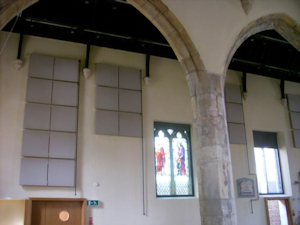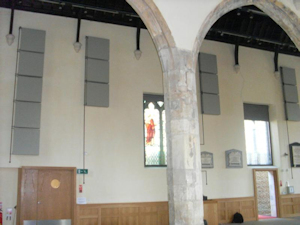
St Margaret's Church, York, UK, dates from the 12th century, the south porch being the only surviving aspect. The nave is 14th century and the tower was rebuilt between 1684 and 1685. Extensive restoration took place in the mid-19th century, with the church finally declared redundant in 1974. In 2000 the church reopened as the National Centre for Early Music and it is now in regular use as a venue and performance space. As part of the redevelopment acoustic treatment was added - reversible acoustic panels are arranged around the main walls of the venue, and drapes hang in the ceiling space above the lighting frame. The acoustic characteristics of the venue can therefore be changed easily depending on its desired use, and hence RT60 values vary from around 2.0s (for large choral ensembles) down to 1.0s (for maximising speech intelligibility) depending on how the panels and drapes are arranged (Figures 15–16).


For this case study three combinations of panels and drapes were used. Impulse responses were gathered using the exponential sine sweep method as source excitation, with a frequency range of 22Hz to 22kHz, and a sweep duration of 15s. A Genelec S30D loudspeaker was used as the sound source (S) placed half-way along the length of the south wall, facing towards the north wall. A grid of 26 receiver positions was plotted and at each a 4-channel measurement was made using a Soundfield SPS422B microphone.
Internet Archaeology is an open access journal based in the Department of Archaeology, University of York. Except where otherwise noted, content from this work may be used under the terms of the Creative Commons Attribution 3.0 (CC BY) Unported licence, which permits unrestricted use, distribution, and reproduction in any medium, provided that attribution to the author(s), the title of the work, the Internet Archaeology journal and the relevant URL/DOI are given.
Terms and Conditions | Legal Statements | Privacy Policy | Cookies Policy | Citing Internet Archaeology
Internet Archaeology content is preserved for the long term with the Archaeology Data Service. Help sustain and support open access publication by donating to our Open Access Archaeology Fund.